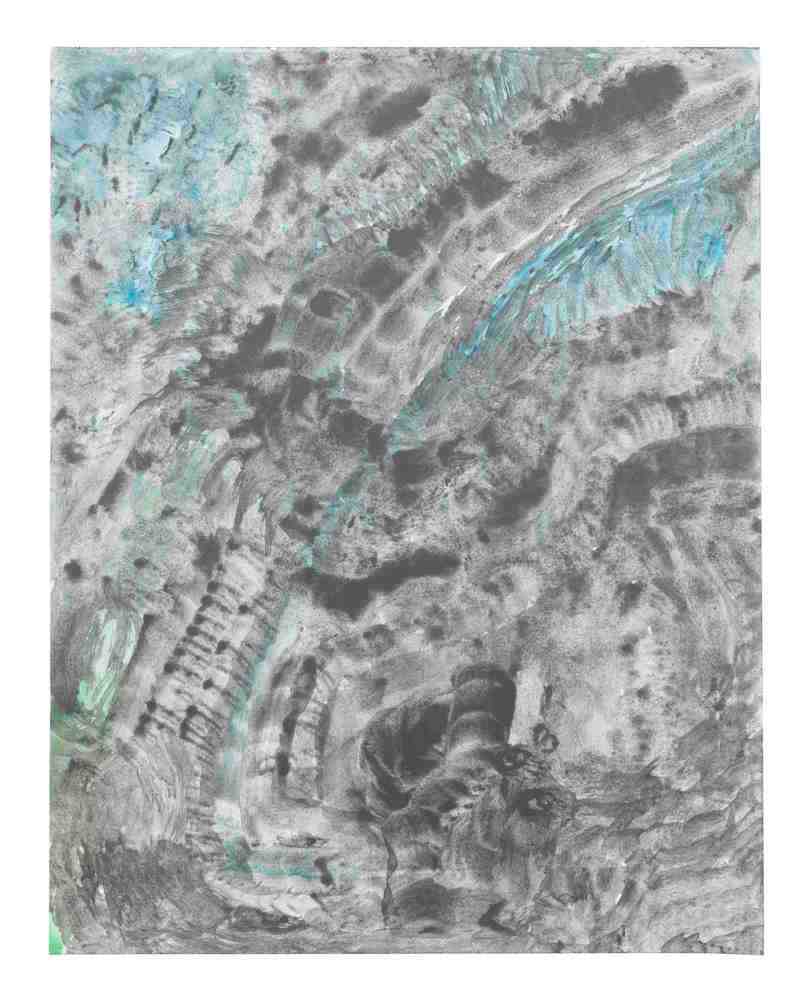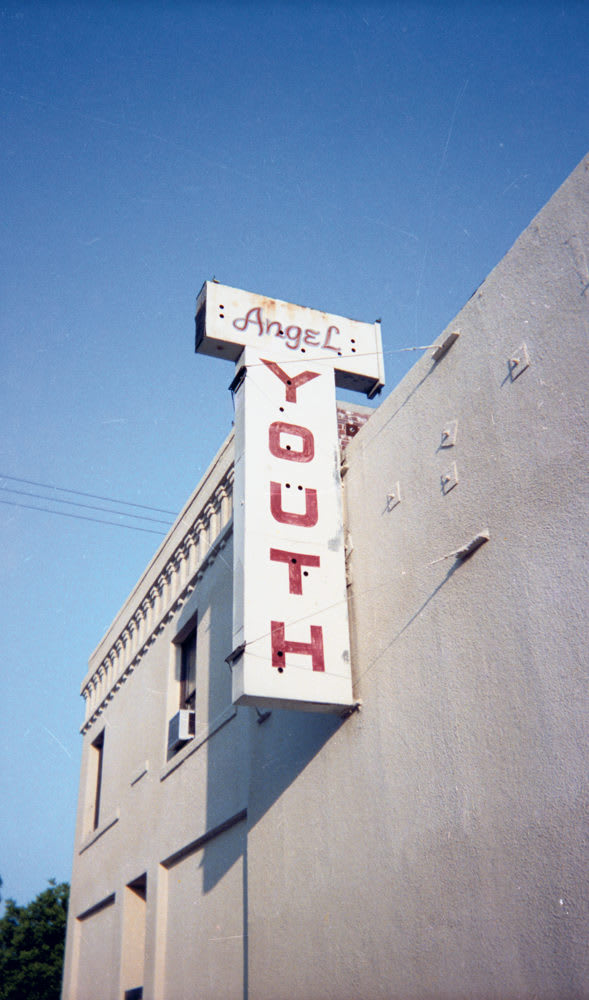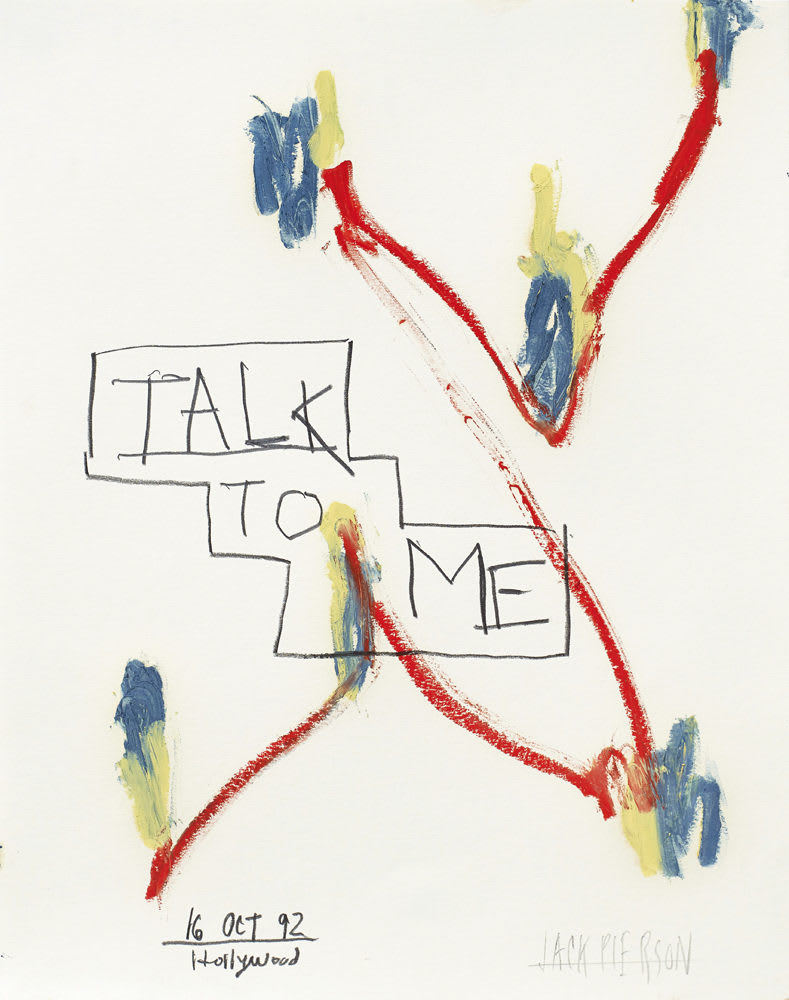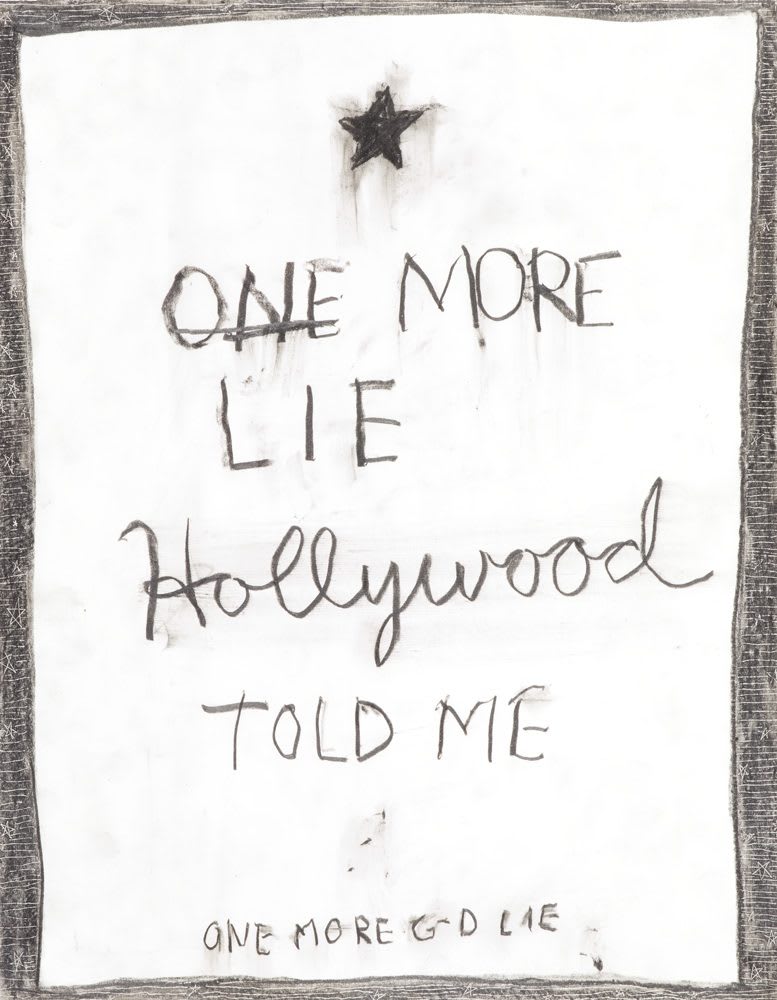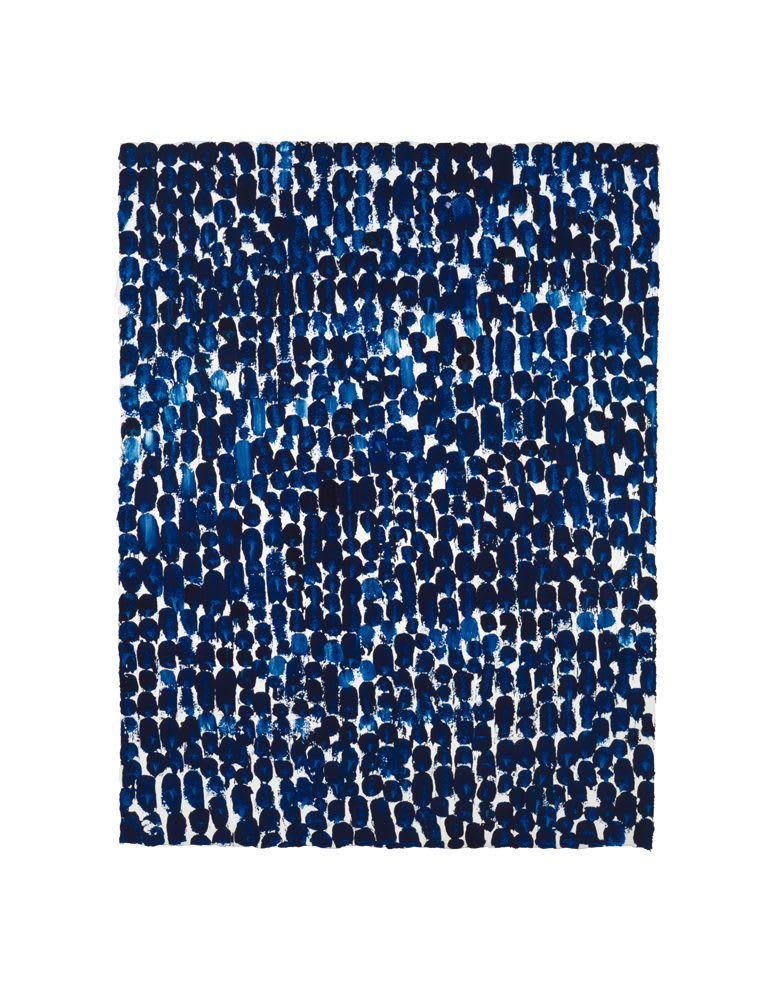
Interview: Jack Pierson and Eileen Myles

On the eve of New York artist Jack Pierson’s new show at the Aspen Art Museum, which restages and rehangs seminal art works Pierson made from 1990 to 1996, he spoke with the poet and critic Eileen Myles about how he started making art and how he made it real.
I interviewed Jack in my apartment on East Third Street, and I’ve got to admit in advance that I bought us a lamp. I bought it about two blocks away, and I walked up the stairs with it. I wasn’t worried about what Jack thought about the lamp (or my apartment), though I did think he just might like to see more. I think of his work as filled with room and light and a complete lack of shame. I was proud to talk with him in my home. I’ve known him for about 20 years, as long as I’ve known this work. If there was a better way of saying he’s the artist “of a lifestyle” (ugh), I’d say that. I mean in exactly the way Westworld is not true, neither is Jack’s work, but that’s what’s so true about it. We’re all out here making stuff up. Of course, he’s an artist who would work mostly in photography, and I love how he explains that here. On his trip to Florida, at age 23, he explained, “I kept using the camera there.”
See, that would be enough. That’s exactly it. He’s very good talking about his work because there’s a kind of directorial affect to it. He came in looking good. He had a kind of gray top coat on, maybe tweedy. Jack is a redhead, so he looks good in gray. He looked handsome. I was glad to have this man come in my home. I poured us some Pellegrino and didn’t ask; I just handed the glass to him, which was really laying on the family or we were getting down to business.
I have written about him before, but I don’t recall ever interviewing him. He said, “I feel like I should be interviewing you,” which was sweet. Though we talked for about an hour, it could have been really brief or much longer. Jack was a little late, which I thought was cool because there was some push pull with the time (not between us), but intuitively I think he had to push back. Because I was interviewing him. Jack is not an artist shy about language. Though it’s all very sexy and worldly, I do think of him as a private or somewhat philosophical artist. The person going look, look is always dropping a curtain. He’s sitting right there. Yes, he is. No, he isn’t. It was a total pleasure to talk with Jack.
____
EILEEN MYLES: When I knew we were talking, I found myself thinking about your work, which I’ve just loved for so long, as well as loving you, and I thought, “What is it?” Your work is notebook-y, it’s sun-drenched, it’s nostalgic, it’s tossed-off, it’s working-class beach, it’s pop, it’s lonesome, it’s tinted. Do you have a response to any of those words? Do any of those trouble you?
JACK PIERSON: Um, no. What do you mean by “tinted”?
MYLES: Some of the ’90s work seems sort of starry from a distance, like you must have been using a filter to create that effect.
PIERSON: Not really. It was just poor focus. [laughs]
MYLES: Okay. So let me be really rudimentary: How did you become a photographer? You were part of the so-called Boston School, with David Armstrong and Nan Goldin and Gail Thacker …
PIERSON: That’s a sort of description added after the fact. We knew each other, but we all were in Boston at different periods, really. I was working class, so when I got to Boston, I guess I thought that the best I could achieve was graphic design, that it would be a good place for my creativity to sit, and it seemed practical. So I went to MassArt in 1980 to be a graphic designer, but within the first couple of months, I fell in with Tabboo! and Mark Morrisroe. And I had acquired a love of photography through my first exposure to a Diane Arbus book. I thought, “Wow, this is really something.” It made me see the achievement of photography. Mark Morrisroe was a photographer. I wouldn’t say I was under his wing, because he wasn’t a very nurturing soul in that capacity. He was like, “Stick to graphic design.” But I took the classes and I felt like, “Oh, I could do this.” Even though it seemed challenging, being around both Tabboo! and Mark Morrisroe—they were strong, they didn’t give you a compliment unless you really deserved it. So I started taking pictures and then I moved to New York a few years later.
MYLES: What year did you come?
PIERSON: ’83. I transferred to Cooper Union on an exchange program and finished my last year there and was doing photography, and that’s where I learned to do color and things like that. After I’d been in New York awhile, I took a Christmas vacation, got paid cash from a gallery I was working at, and we just drove to Florida. We spent all the cash and couldn’t get back.
MYLES: Who’s we?
PIERSON: I had a boyfriend at the time named Andre, a French-Canadian who I had met in Provincetown. He didn’t know he was my boyfriend, but you know … I wore him down somehow, one of those things. So we got there, we’re broke, and I kept using the camera there. It was such a different place than I had ever been—New England, away from those guys, or New York—and the idea that I had to make it somehow. I was the same age as Keith Haring and Jean-Michel, and they’d already been flying the Concorde and partying with Grace Jones for years. And I’m making things out of bottle caps and pieces of old fruit crates. I just didn’t see myself having that happen right away. So Miami Beach seemed pleasant—55-dollar room by the beach.
MYLES: I met you in 1990 or something, and that’s when I got to know your work. There’s a piece in this show in Aspen, which is your ’90s work, that has this amazing little table with the ashtray and some cigarettes and a drink [the installation Diamond Life, 1990].
PIERSON: Exactly. That’s me in 1989, ’90, already memorializing my youth in 1983. Seven years later I was like, “Christ, where would I go if I could go anywhere?” And it was back to that room in Miami Beach. I was re-creating it.
MYLES: That piece really changed something for me. There was an autobiographical quality to it. It was an installation, and it managed to be so intimate and so fucked up and sweet. It had that quality that you do a lot. It was photographs, it was words on paper, it was letters on the wall. In my mind, you were an artist who enacted a group show; suddenly, I was like, “Oh, a group show can be one person.” You’re a photographer, but there’s always a question of whether you’re in the picture or taking the picture.
PIERSON: Yeah, I think that was something I hadn’t figured out. But as I entered the playing field, I knew I wanted to keep it wide open for me to do what I wanted to do.
MYLES: There’s something very performative about that.
PIERSON: Even those installations you’re talking about, I feel like they come out of a performative photographic sensibility. They could have been stage sets. In fact, it was my intention at the time to go back and take pictures that I should have taken better in that room, on these sets. I never did that, but that was the logic.
MYLES: I don’t understand. What do you mean by “I’ll go back and take the pictures I should have taken better in that room”?
PIERSON: I guess I mean that I was building these sets, and then I could re-imagine the life in them. The coolness of those sets is that they got to be real. I feel like I’m good at re-creating real.
MYLES: I think you are, too.
PIERSON: I have no problem telling you that real is a style. Of course, it’s not real, but I’m very good at giving the style of real.
MYLES: Do you think it’s something about boundary-less-ness, too? Real always has some extra shit to it. Art feels like it has this frame, and it’s either outside or inside. One of the things about your work is that it feels like it’s about to happen or just happened. The moment is not exactly set in stone.
PIERSON: It’s true. Even though I’m not actually performing in the works, I love the theatrical and have this fan relationship to showbiz. And one of the things that’s a disappointment to me about art is that it’s always a memory of something that happened. So I try to get as intimate or as real as possible. When I was doing those early drawings, I was really heartbroken and sort of despairing. So I adopted the technique or guise of doing those drawings like a sad lonely person would at night writing in their journal.
MYLES: The writing is such a piece of it. In my cases, those drawings are almost poems, like you’re leaking into some mental shit.
PIERSON: Right. And to do that work, I had to imagine myself like the person who would do that sort of thing. Until I finally come to the realization that, no, I am a person who does that.
MYLES: And when does that realization happen in the course of the work?
PIERSON: I had that realization early on. It was for a work where I was making all of these collages out of ’50s porn that I was collecting off the street. I would cut it up and tape it together and was like, “I want this to look like a crazy guy in Times Square who’s just filling the walls of his SRO, cutting and taping. I want it to look like walking into a crime scene.” And then I suddenly realized, oh my God, I am doing this.
MYLES: But your work is about class in some way, too, isn’t it?
PIERSON: I guess. I like that you said the working class. I think that’s part of every excuse I have for not being a better, more sophisticated, intellectual artist. It seems so far-fetched that I’m doing it at this point. I had a big comeuppance sitting at the counter at Veselka [a diner in the East Village], in maybe ’93. I had already shown at the Whitney, and some guy starts talking to me. He was like, “What do you do?” And I was like, “I’m an artist.” And he was like, “You don’t sound very enthusiastic about it.” I was like, “It just seems so weird to say. But I am.” It was a touching New York moment, because he was telling me that I should be happier about that.
MYLES: That’s so great. It’s almost like a good version of your family.
PIERSON: Just a stranger on a diner stool.
MYLES: All of that is something I feel I can see in the work, this kind of wondering if I am that guy. He’s not there, but it’s like he just was there, and it seems like the work can’t quite hold him. There’s a whole identity question going on, but it’s not about fixing identity; it’s about unfixing it, which is really great.
PIERSON: The key word when my work was being written about from ’90 to ’95, when I was 30 to 35, was adolescent. Now, Christ, at 56 I find it very difficult to do one of those drawings of heartbreak or despair, not even for how it would look, it just doesn’t seem the same. I have attempted in the last ten years to try it, like, “I know how to do this. You use your left hand and really jerk around and write something heartbreaking.” It doesn’t work.
MYLES: You’re not him anymore.
PIERSON: You can’t get back to that, somehow. So it’s interesting.
MYLES: That was something I was wondering; first of all, how does it feel to look at this body of older work? And also, is the work something you made to protect this guy—the one who made the work? How does all this work feel now?
PIERSON: It feels pretty good. I feel like I got at something, even in my naiveté and in thinking I was one step removed. The odd thing I realize now in trying to bring back the work for this show—it’s not a retrospective—is that I was never making anything with the idea that it had longevity. Even letters can go back to being junk the minute you take them off the wall. When I had a show, I never used to deliver a template. It was just, “This is the stuff. You put it up.” And the drawings were like, “How weird will this be if someone finds this piece later in a house in its little white frame?” I didn’t photograph any of it, so there’s no complete record. And maybe that’s the working-class thing, too. I was just like, “If somebody’s ready to pay $75 right now, they can have it. I don’t need a photograph of it.” Now I do care more deeply about them. But I’m still committed to this idea of It’s just in the wind. Part of my struggle with being an artist is … Well, the first nervous breakdown I had was about the concept of eternity and how little we are in the scheme of things. And I would think, [gasps] “Who cares?” It’s amazing that things last from 300 B.C. and are still around, really. So most of my work is very temporary, very provisional. You can take it with you or you can leave it. Which is a tough sell for art. Because part of what art is supposed to do is make you immortal, either by making it or owning it.
MYLES: Except that when people were doing all this work in the ’60s or ’70s, that was performative and stuff, the only ones that we know about now are the ones who figured out that somebody better pick up the camera and make a copy. But you were making actual objects and you weren’t asking for anybody to necessarily document it. It was more that it simply existed.
PIERSON: I figured if it exists, it exists. They can find it again.
MYLES: But, for example, the table in the installation actually exists.
PIERSON: Yeah, and there are photographs. But the other thing is this implied value. If it exists, it might be in a museum, and that means someone paid money for it, but it’s still just cheap linoleum tile glued to Masonite and a clamshell ashtray. It’s not really there, you know? Which is, I guess, the same as Duchamp. I do realize now that, at the time, what I thought was art was really my life. And then there was the tinsel stage that came out of a million nights of being in a nightclub and thinking, “Nothing is better than this drag queen. Fuck the rest of this shit, this is it.” In my tinsel stage, I tried to make my work seem like I just X-Acto knifed it out of a barroom. I didn’t want it to make it anything more or better than it was.
MYLES: It’s interesting to think about this moment in terms of gender, and there being today such a bigger conversational presence in wider culture around trans issues. But in 1991, you were making work about a drag queen onstage where a certain audience was coming out to be a part of this “conversation.” Nobody was writing books about it or even saying, “We have a right to exist.” It was almost like people were saying, we don’t have a right to exist, and so we all need to be in here together. It was a very interesting time.
PIERSON: Right. And the other interesting thing that only came to me fairly recently that I feel was a big genesis of my work is that, after I would leave those nightclubs at three in the morning, there was the open market on Second Avenue with people selling stuff on blankets. As I wandered home, I would go there every night. And on these blankets was a very Joseph Beuys piece on a certain level. I, as young, naive, or just not very smart, always thought, “Oh my God, they stole all this stuff. Here are the ’50s porno magazines, here are snapshots, here’s James Baldwin, here’s Tennessee Williams. Look, you can see the whole life: ashtrays, pornos, a pretty good piece of ’40s pottery.” But I would think, “Wow, this is a whole life. I hope they didn’t rob the guy blind.” And then it dawned on me about five years ago, these were the contents of gay guys’ apartments who were dying of AIDS that had been thrown out. I might have known that much then, but I wasn’t aware that I had internalized it, that it was where those installation pieces came from in a big way. It was more like, “I want my gay life to not wind up on the streets-on Second Avenue. But at the same time, I don’t care if it does.” That’s why I like to make books. To me, it’s just as great to have some book of mine be in a flea market as it is to have a picture in a museum. I really stand by that because that’s how I got information as a child.
MYLES: It’s great because that also means the gallery and the museum become a dumping ground.
PIERSON: On a certain level. Part of the reason I play the game is so people will publish things and there will be more ephemera that will get out farther.
MYLES: What do you mean by “the reason I play the game is so people will publish things.” I love the sound of that.
PIERSON: Part of my impetus to get famous is to have access to printed matter. I love all the stuff like postcards, books, little things. I can make my own zines, but it just helps if you’ve got somebody behind you publishing things.
MYLES: Right, so they make your museum for you.
PIERSON: I like both sides of the cultural stream. Because it does go far and wide.
MYLES: Are you a Robert Smithson fan?
PIERSON: Yes.
MYLES: That whole inside/outside thing, right? For him, the gallery was sort of a retrospective of reality, where he was leaving things in the desert someplace. I think writing feels like that for you, too. Some of the drawings, which are writing, it’s like you’re writing on a mirror.
PIERSON: Some of them are supposed to look like that.
MYLES: When it’s like that, it’s like saying that the act of writing isn’t so this will be closed and in a book, but more so this will be seen here now. It’s sort of like what comes from inside goes outside, and then it gets echoed again in the gallery. It just keeps being reflected, instead of the pages turning.
PIERSON: One of the things I’ve had to struggle with is that part of what people find critically and curatorially questionable in my work is that I try to make things that don’t read as art until they’re in a gallery.
MYLES: It’s like that Marcel Duchamp thing: Does the audience complete the work, or does the gallery complete the work? Or do the people who come into the gallery and see the work in the gallery complete it?
PIERSON: Exactly. But it’s also a hard thing for me to maintain, because all of a sudden you get seduced into things like, “Oh, they can afford these nice frames—go ahead.” There are little seductions. But that was my intention early on; leave nothing behind that looked like art too much.
MYLES: And again, that seems like class. It’s sort of like a safety valve; I’m not really saying it’s art.
PIERSON: But then, I went on painter trips. Like, “Now I’m a painter, and this is what a painter does.” A lot of it is acting.
MYLES: I love those oil-stick paintings that are in the show.
PIERSON: The blue, which I did in Provincetown.
MYLES: Yeah, and they’re theatrical. One was called The Essex. What’s the Essex? Is it a hotel?
PIERSON: It is a hotel, but to me, it’s this old ’50s rock ‘n’ roll group.
MYLES: Just the name was so evocative. You look at the painting, which is so abstract, and then you hear the name, and it just flips you into a space.
PIERSON: Then at the same time, it’s offhand. It wasn’t like, “These are the marks the Essex would make.” It was the music that was playing while I made it, something like that. And then that was a whole act of performance, because all of a sudden I had been given this Fine Arts Work Center fellowship in 1993, and I was in Provincetown for the winter, so I was like, “I’m an artist now, what will I make? I’ve got all this time. I’m going to make some abstract paintings.” So I started making these marks with my finger, or to approximate my finger. I want to show I can make something with my hands. Digital paintings were on the horizon, and I was reading a lot about computers, 1s and 0s. So I thought, “I could make digital paintings.”
MYLES: Well, your hands have digits. So let me repeat the big question: How does it feel looking at all this work that’s 20 years old, and you’re not necessarily that guy, but you were that guy, and you did that work? What does it feel like?
PIERSON: It’s a little scary. One of the other things I lived by in the early years was that I wanted my retrospective to look like a really good thrift store where you found lots of good stuff. But now, talk about class, it’s Aspen, it’s a very beautiful museum, these are very fancy people used to the highest quality. I don’t want to be in a thrift store! So we’ll see. Maybe we make the best version of a thrift store.
MYLES: Part of me thinks of there being a house somewhere where you install this whole body of work.
PIERSON: I don’t know. But it does feel like a natural progression somewhere, from there to here and how long it took me. My first show was when I was 30. It took me that long to figure out exactly how to fit in or what mattered to me. And it was all kind of okay somehow. It worked out. It wasn’t like, “I’m going to be an artist, and this what I’m going to do.” It was more like, “Well, what about this?”
NEW YORK AND MARFA, TEXAS-BASED WRITER EILEEN MYLES’S NEXT BOOK, A MEMOIR, IS DUE OUT SEPTEMBER 2017.
